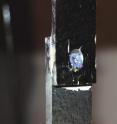Research at UC3M improves the bolted joints in airplanes
The idea for this research arose when the problems of the large structural components of an airplane were being analyzed. These components are made up of a large number of different elements, which are themselves assembled using a variety of techniques, such as soldering, mechanical or adhesive bonding or a combination of these. Of these techniques, mechanical bonding is the method most commonly used in components made of composite materials. For example, the wing of an Airbus 380 alone is composed of over 30,000 elements, with approximately 750,000 bolted joints. These joints are of key importance since they form a weak point that can contribute to the breakage of the element, as well as increase the weight of the aircraft if the design is inefficient, thus raising the aircraft's operating cost. The researchers have analyzed the performance of these bolted joints in aeronautical structures in which mechanical elements (screws, nuts, washers) are used to join parts that are made of composite materials. Specifically, the scientists at UC3M have analyzed the influence of bolt torque (the force with which the bolt is tightened) and temperature, which varies from -50ºC, when the airplane is flying at an altitude of 10,000 meters, to 90ºC, the temperature to which a bolted joint may be exposed when it is close to a heat source. To do this, they developed a numerical model and analyzed the behavior of these joints under different conditions. "The main conclusion that we drew is that the torque of each joint should be estimated taking into account the range of temperatures to which the plate is going to be subjected, because current industry standards that are applied to determine torque do not take this effect into account", explains one of the authors of the study, Professor Enrique Barbero, head of the Advanced Materials Mechanics research group of the Department of Continuum Mechanics and Structural Analysis at UC3M, which has recently published the study in the Journal of Reinforced Plastics and Composites along with Professors María Henar Miguelez and Carlos Santiuste.
The main type of failure that they found was the crushing of carbon fiber plates against the shaft of the bolt, which is made more likely by low temperatures or by low torque levels. "At -50ºC the volume of the panels is reduced and the effect of the torque is diminished, so the joints that are subjected to these temperatures, such as those that form part of the fuselage and the external structure of the airplane, should have a greater torque so that its effect is maintained even under very low temperatures", affirms Professor Carlos Santiuste. The opposite effect can also be dangerous, the researchers point out, because when temperatures are high or when the torque is too great, the panels made of composite materials may be damaged by being compressed between the head of the bolt and the washer.
This study may have several applications. Optimizing the design of bolted joints in aeronautical structures would allow safety coefficients in the design to be reduced, which would result in a lower structural weight. This reduction would then lead to lower fuel consumption and, therefore, a reduction in the aircraft's operating costs and its impact on the environment. Along these lines, the development of more energy efficient airplanes with a lower environmental impact falls within the "Clean Sky" initiative that is part of the Seventh Framework Programme of the European Union.
This research has been approached with a global view, taking in everything from the design phase through the operation of the structural elements, giving it a markedly interdisciplinary character. In order to do this, collaboration between two research groups from different departments of the UC3M was established. These are: the Department of Advanced Materials Mechanics, coordinated by Professor Enrique Barbero, which focuses on the study of lightweight structural elements; and the Mechanical and Biomechanical Component Manufacturing and Design Technology section of the Mechanical Englineering Department, lead by Professor Mª Henar Miguelez, which works on the study of mechanized processes. In this way, the researchers were able to analyze the problems in these joints, which combine a temperature problem and a mechanical one, due to the effects of temperature and torque. "This kind of collaboration between research groups is very interesting, as the majority of the most relevant lines of research are interdisciplinary in nature, and it allows us to take on more ambitious lines of research", comments Professor Barbero. As a result of the experience gained through this project, a proposal submitted to the National R + D + i Plan has been accepted and will receive enough funding to continue this line of research for the next three years, and to carry out a series of experimental tests.
Source: Carlos III University of Madrid
Other sources
- Research improves the bolted joints in airplanesfrom Physorg13 years ago
- Research improves bolted joints in airplanesfrom Science Daily13 years ago


